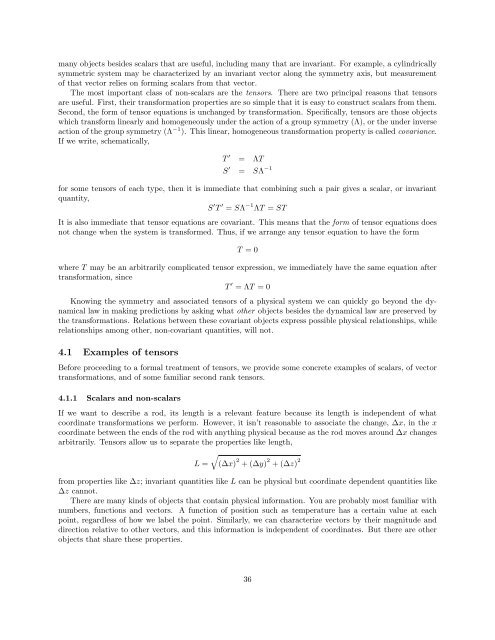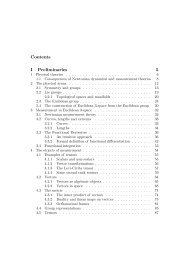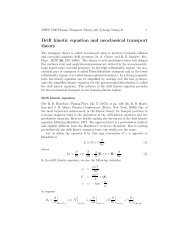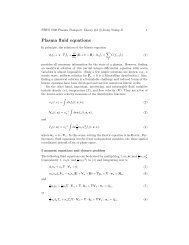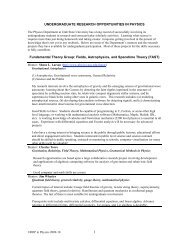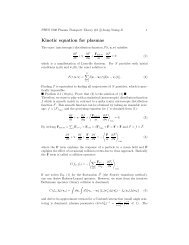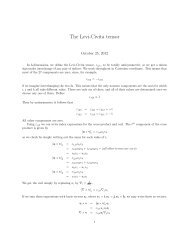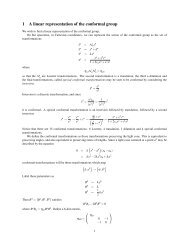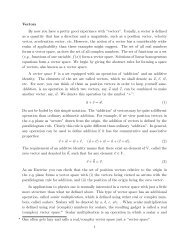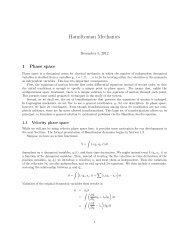Wheeler, Mechanics
Wheeler, Mechanics
Wheeler, Mechanics
Create successful ePaper yourself
Turn your PDF publications into a flip-book with our unique Google optimized e-Paper software.
many objects besides scalars that are useful, including many that are invariant. For example, a cylindrically<br />
symmetric system may be characterized by an invariant vector along the symmetry axis, but measurement<br />
of that vector relies on forming scalars from that vector.<br />
The most important class of non-scalars are the tensors. There are two principal reasons that tensors<br />
are useful. First, their transformation properties are so simple that it is easy to construct scalars from them.<br />
Second, the form of tensor equations is unchanged by transformation. Specifically, tensors are those objects<br />
which transform linearly and homogeneously under the action of a group symmetry (Λ), or the under inverse<br />
action of the group symmetry (Λ −1 ). This linear, homogeneous transformation property is called covariance.<br />
If we write, schematically,<br />
T ′ = ΛT<br />
S ′ = SΛ −1<br />
for some tensors of each type, then it is immediate that combining such a pair gives a scalar, or invariant<br />
quantity,<br />
S ′ T ′ = SΛ −1 ΛT = ST<br />
It is also immediate that tensor equations are covariant. This means that the form of tensor equations does<br />
not change when the system is transformed. Thus, if we arrange any tensor equation to have the form<br />
T = 0<br />
where T may be an arbitrarily complicated tensor expression, we immediately have the same equation after<br />
transformation, since<br />
T ′ = ΛT = 0<br />
Knowing the symmetry and associated tensors of a physical system we can quickly go beyond the dynamical<br />
law in making predictions by asking what other objects besides the dynamical law are preserved by<br />
the transformations. Relations between these covariant objects express possible physical relationships, while<br />
relationships among other, non-covariant quantities, will not.<br />
4.1 Examples of tensors<br />
Before proceeding to a formal treatment of tensors, we provide some concrete examples of scalars, of vector<br />
transformations, and of some familiar second rank tensors.<br />
4.1.1 Scalars and non-scalars<br />
If we want to describe a rod, its length is a relevant feature because its length is independent of what<br />
coordinate transformations we perform. However, it isn’t reasonable to associate the change, ∆x, in the x<br />
coordinate between the ends of the rod with anything physical because as the rod moves around ∆x changes<br />
arbitrarily. Tensors allow us to separate the properties like length,<br />
√<br />
L = (∆x) 2 + (∆y) 2 + (∆z) 2<br />
from properties like ∆z; invariant quantities like L can be physical but coordinate dependent quantities like<br />
∆z cannot.<br />
There are many kinds of objects that contain physical information. You are probably most familiar with<br />
numbers, functions and vectors. A function of position such as temperature has a certain value at each<br />
point, regardless of how we label the point. Similarly, we can characterize vectors by their magnitude and<br />
direction relative to other vectors, and this information is independent of coordinates. But there are other<br />
objects that share these properties.<br />
36


